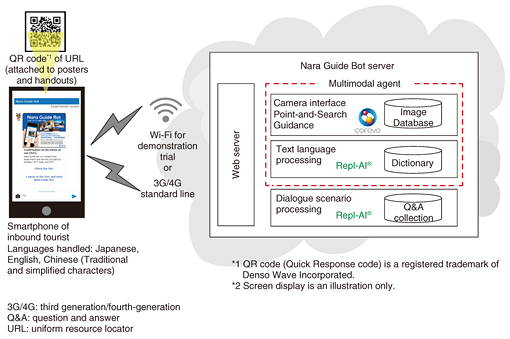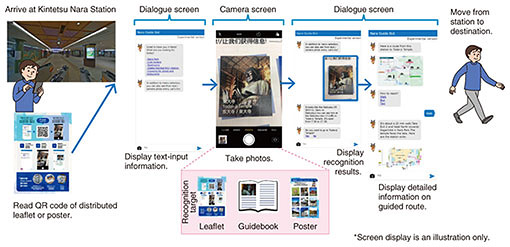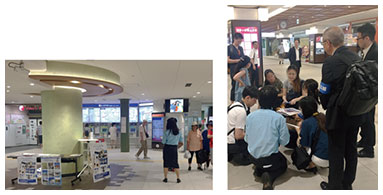 |
|||||||||
|
|
|||||||||
|
Feature Articles: New Value Creation through Collaboration with B2B2X Partners Vol. 17, No. 1, pp. 28–34, Jan. 2019. https://doi.org/10.53829/ntr201901fa6 Demonstration Trial of Nara Guide Bot—Kintetsu Railway and NTT Group’s Jointly Developed Information Guidance Service for Train StationsAbstractThere are many sightseeing spots along the railway lines of Kintetsu Railway Co., Ltd., including Nara and Ise-Shima, and the number of international tourists to these areas is rapidly increasing. In this article, we introduce a demonstration trial conducted at Kintetsu Nara Station of a tourist-guide service for inbound tourists. The service is called Nara Guide Bot and uses NTT’s multimodal Agent-AI (artificial intelligence). Keywords: AI, tourism, image recognition 1. Sharp increase in number of international visitorsThe number of foreign nationals visiting Japan reached 28.69 million in 2017 after consecutively breaking the record for the preceding five years. The Japan National Tourism Organization (JNTO) reported in July 2018 that the number (estimated) of arriving visitors during the first half of 2018 (January to June) was 15.899 million, an increase of 15.6% over the same period in 2017. JNTO also announced that this number was the highest ever [1]. The 15-million mark was reached a month earlier than the previous year, which marked the fastest increase in Japan’s history. Each prefecture in the Kansai region (western Japan) has also broken its record high. The (estimated) number of arriving visitors to Nara Prefecture in 2017 was 2.09 million, which is double that just two years earlier when it exceeded 1 million for the first time. 2. Seamless guidance informationKintetsu Railway Co., Ltd. (Kintetsu) is working on seamless guidance for all customers, including inbound tourists, whose number is rapidly increasing as described above (Fig. 1).
Seamless guidance is a collective term for an information service provided by Kintetsu that is aimed at ensuring smooth use of railway services for all customers irrespective of age or language. Here, the meaning of seamless is considered twofold: first, customers moving smoothly and seamlessly to their destinations, and second, a system that is useable by all customers regardless of age or language. The use of smart devices such as smartphones and tablets has increased around the world for all age groups, and we aim to create various services by utilizing such devices. 3. Present status of Kintetsu Nara StationKintetsu Nara Station is the station on the Kintetsu Line visited most often by inbound tourists to Japan. Multilingual concierge staff are currently employed to give these visitors the guidance they need verbally. Although enquiries from customers to staff members and concierge staff form general patterns, the number of enquiries continues to increase along with the increasing number of customers. The results of observing and analyzing the trends of passengers using the Kintetsu Line for sightseeing—regardless of whether they are domestic or international visitors—revealed that many of them search for information on their own smartphones, record things by taking pictures, and try to make decisions by themselves. In other cases, passengers pointed to the screen of their smartphones while asking station staff for information. 4. Investigation of demonstration serviceIn cooperation with Kintetsu and NTT, NTT WEST investigated the demonstration service by carrying out the following actions. (1) Interviewing staff at the foreign visitors desk/concierge at Kintetsu Nara Station (2) Observing the behavior of inbound visitors to Japan (3) Analyzing the contents of enquiries The investigation indicated that there is a strong need for the concierge function, and it is expected to continue increasing as the number of tourists visiting Japan increases. Accordingly, we decided to create a demonstration service to solve problems revealed by behavior patterns of visitors from their arrival at the station to their reaching their desired sightseeing spot (Fig. 2).
5. Multimodal Agent-AI and demonstration serviceVarious artificial intelligence (AI) services are already available around the world. However, most of them have only a single means of inputting information (i.e., only text, images, or sound). This means that if a problem cannot be solved with one AI service, the user has to go to the trouble of activating and switching to another AI service. Multimodal Agent-AI is an agent AI with multiple communication modes that utilizes NTT’s corevo® technology. If a specific AI cannot answer a question, the system hands it over to another AI. Thus, it is possible to provide useful information quickly while reducing the time and effort of the user operating the AI. We used the results obtained from the investigation of the demonstration service to develop a chatbot using textual questions and image-type questions as a demonstration service system called Nara Guide Bot. With the multimodal Agent-AI, if a visitor finds it difficult to ask a question via text, the user can still send images of objects and photos and ask image-type questions by using the camera-interface AI (Fig. 3).
The camera-interface AI utilizes Point-and-Search Guidance, which is a service developed by NTT for displaying route guidance, detailed sightseeing information, and other information in the language set on the user’s smartphone [2, 3] when the user holds up their smartphone and points it at information signboards, buildings, products, or other items. Angle-free object search technology [4] (one AI technology used in corevo) makes it possible to recognize the object with high precision even if the smartphone is held obliquely or if the target is blocked. In addition, we have developed text language processing and dialogue scenario processing, which are the basis of the chatbot, using the chatbot platform called Repl-AI® provided by NTT DOCOMO and Intermedia Planning, Inc. (Fig. 4).
6. Overview of demonstration trialIn the demonstration trial at the location and period stated below, multilingual staff briefly explained the service to actual inbound tourists before use. After the tourists had used the service, they were asked by questionnaire about its usability and their intention of using it (Figs. 5 and 6).
In addition, posters were hung, and leaflets were distributed in a corner of the East Gate, outer concourse, and the trend in use by inbound tourists was measured. 7. Results of demonstration trialDuring the two-week period in which the demonstration service was open to the public, many travelers using Kintetsu Nara Station tried the Nara Guide Bot. We questioned over 400 inbound tourists by questionnaire; the results are summarized below. (1) Regarding the usability of the service, over 90% of respondents said that the service was easy to use. The most common reason for this response was “Inquiries can be made using photographs,” which greatly exceeded the reasons “Inquiries can be made by text selection” and “Inquiries can be made via text input.” This result confirmed that the multimodal Agent-AI, which makes it possible to ask questions by sending images of objects and photographs, is effective from the viewpoint of inbound tourists. (2) As for intention to use the service, more than 90% of respondents replied that they would use the service in the future, and this result confirmed the acceptability of the demonstration service. (3) As for content, a large number of requests to expand the range of use were received from users. For example, in addition to route guidance starting from the station, route guidance starting from the user’s current position while sightseeing was requested. 8. Future developmentBy utilizing the technology developed through this demonstration trial as the platform of seamless guidance provided by Kintetsu, we aim to create a new tourist information service with three key features: (i) provision of intuitive language-independent transport-usage guidance and tourist information, (ii) support of station staff and tourist information concierge, and (iii) proposal of a highly satisfactory tourist route through analysis of collected data. In addition, we will work toward practically applying solutions utilizing AI and other ICT (information and communication technology) tools such as Point-and-Search Guidance and chatbot, and contribute to solving social issues concerning the inbound tourist and transport industries. References
Trademark notesAll brand names, product names, and company/organization names that appear in this article are trademarks or registered trademarks of their respective owners. |
|||||||||















